Hot beds have been used for many years. They were part of the gardener’s tool kit in the Victorian era and probably well before that. One of my newsletter subscribers, engineer David Howells, shares how he has built and uses hot beds today.
David lives in South Wales. Over the last two years his lockdown passion has been vegetable gardening. He’s been experimenting with sustainable gardening. In particular growing veg over winter on top of hotbeds.
Construction
The total bed is 2.4m long and 1m wide and 700mm high (27”) made from 9×2’s plus another 5” high from the lids. The beds sink as they decompose so can get roughly 7” growing space height at this time of the year (January) but they will drop about another 5” over the next couple of months.
Each bed has a lid which is closed at the end of each day (after taking the temperature readings). The lids are made from old decking boards. All beds are lined with plastic and membrane on the base to allow water to drain.
The beds are filled with fresh manure along with the stable straw etc. As this rots down it produces heat which is the basis of the hot bed. Traditionally this is cased by covering with around six inches of sieved fine soil.
Results
David tells me;
Last year had both oldish (6/7 weeks) and fresh manure in the hotbeds and managed to grow salad leaves, radish, spring onion throughout the winter months, no problem. In November 2021, dug out the previous year’s hotbeds and had about 1300 litres of free compost from the decomposed straw and manure ready to use for 2022 season and used half the compost to rejuvenate and feed the remaining 5 raised beds in the polytunnel with loads to spare.
New hotbeds built with fresh manure at the end of November 2021. Instead of growing veg in the topsoil, using trays on top of the beds and results so far are fabulous. The beds are mid 25ºC and the soil in the trays around 15ºC, more than enough for germinating the majority of veg to be grown over winter.
Basically a large propagator using natures alchemy!
There are plenty of worms in each bed too to help with the decomposition. The final compost is Ph 6.7 ish so pretty neutral and good N, P, K values so no need to add additional fertilizer.
Temperature Data from the Hot Beds
Being an engineer, David like to work from the data. He’s provided a detailed chart of last year’s data and tells me
This years data has much higher temperatures but only 7 weeks in – one of the beds hit 40ºC after 4 days! Now a balmy 25ºC!
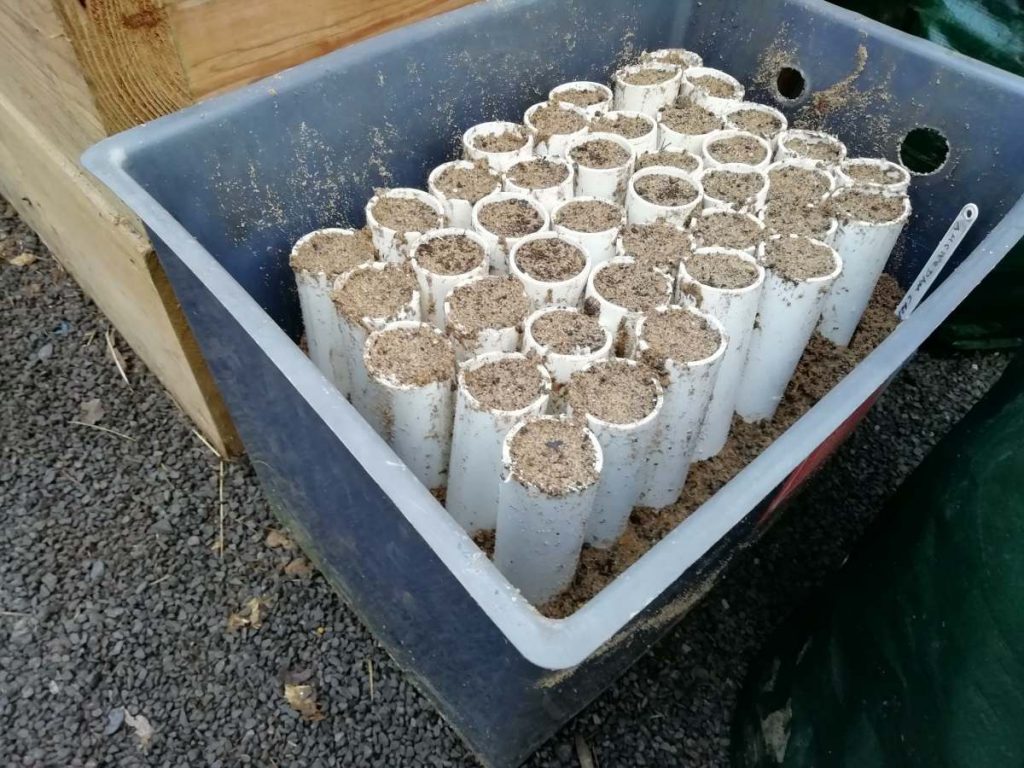
Amsterdam carrots planted in plastic pipe as they are dead straight after years of forked and king prawn like carrots – works a treat in a much reduced space in a 60/40 sand/compost mix – 40 carrots sown.

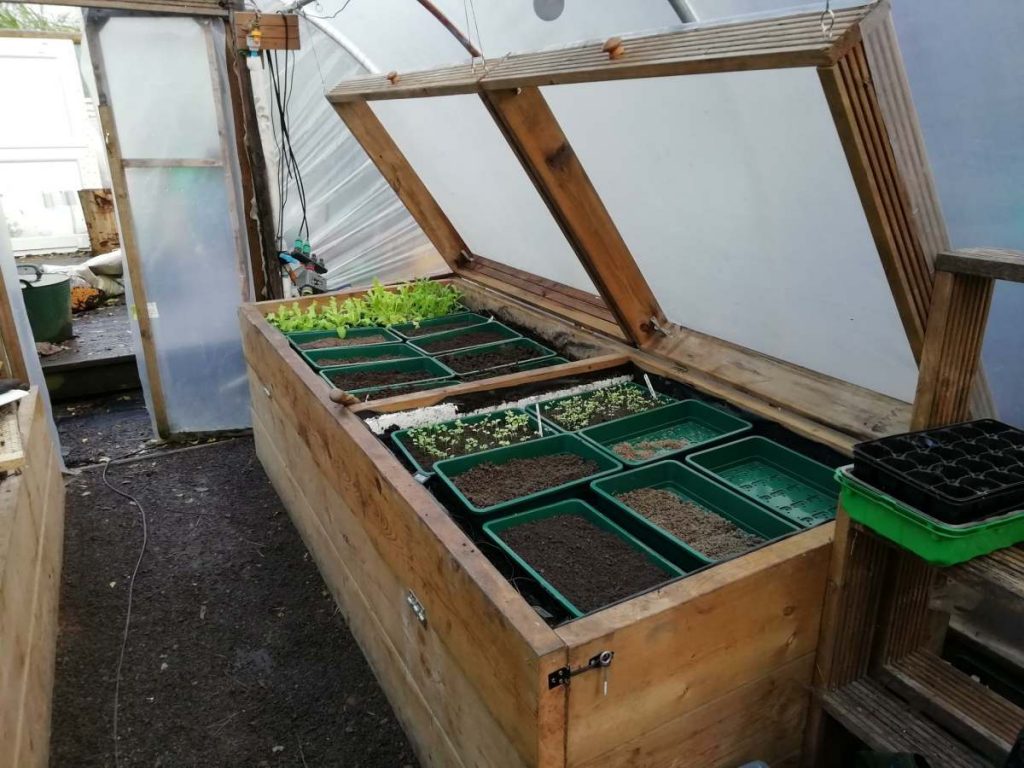
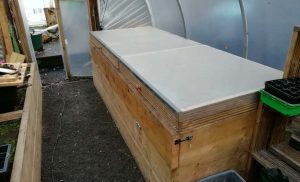
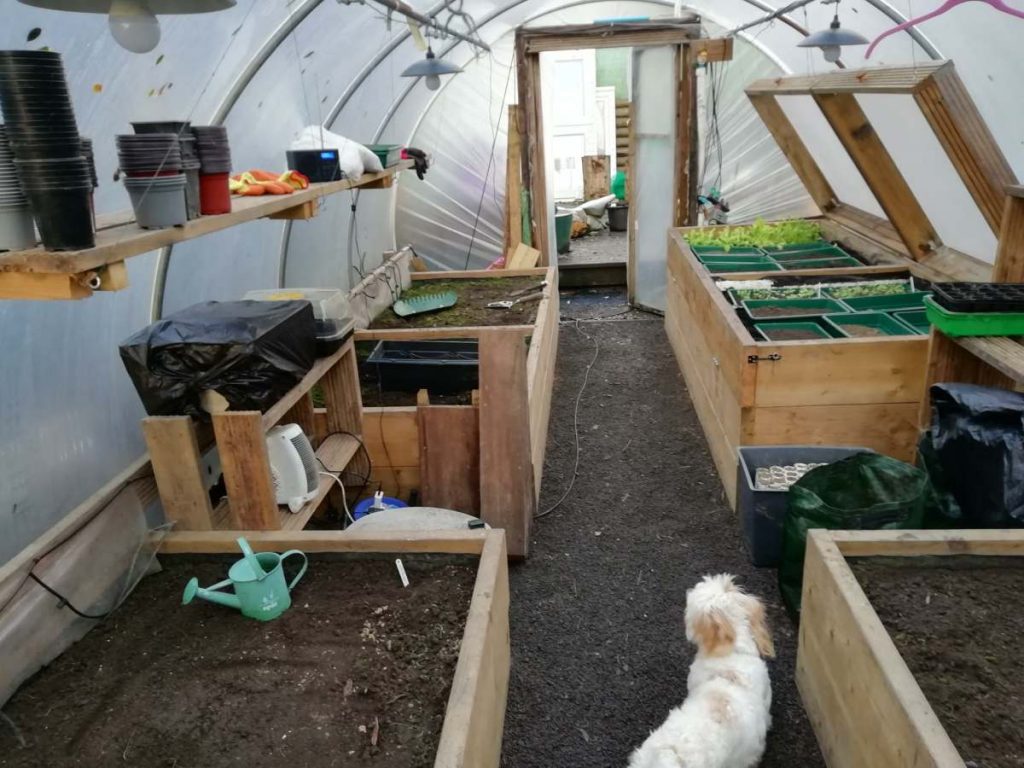
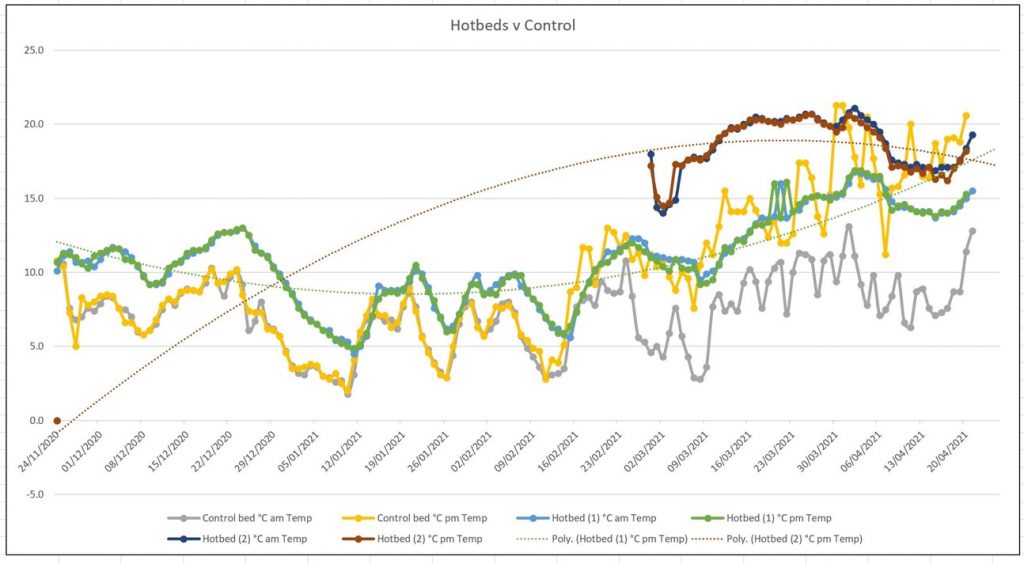



John, this is so fascinating!
A few yards from ‘The Turrets’, is a converted greenhouse which used to be the workplace for a big country house. The actual glass area is listed, so a careful owner (Peter and Carol – good chums), got planning to use the potting sheds behind, and adding a suitable structure for a kitchen etc, managed to convert it for a new home!
The original details are from The Daily Mail here…
https://www.dailymail.co.uk/news/article-3693408/The-couple-created-unique-family-home-old-Victorian-greenhouse.html.
There is one photo of the exterior about half-way down, which shows just the GH and an attached building to the left. Under the GH side (the south), are about eight beautiful gauged brick arches with about 2’0″ max clearance off ground level. All the manure from the stables nearby was stacked inside for this very purpose!
I’ve always been fascinated by this simple but effective method for heating a GH, and I know the new owner well, so I hope she doesn’t get loads of visitors clamouring to take a look!
John, I’ll try and find an aerial pic of the outside gardens for Lillesden, as the layouts, rows etc, are spectacular!
Great post, thank you!
Mike.
Many thanks for this post, very interesting. Question, is it suitable to use chicken/duck manure ?
Many thanks for all.
Michael
Hi Michael
I did look into using chicken manure but have access to fresh horse manure. I dont see why it wouldnt work though.
Cheers
Dave
A thoroughly enjoyable article. I am wondering do you think a scaled down version would work? If so what would be the smallest size that would /could give me good results.
I think that a smaller bed could well generate useful decomposition heat. Worth trying and seeing!
Very impressive,
Just wondered if you had any problems with flies around the hotbed?
Hi Gill
I did before I covered with a couple of inchest of compost on top of the bed and that did the trick.
Cheers
Dave
I love the idea. Seems a big and permanent unit. I have a smallish 10×6) polytunnel with 2 raised beds full length of the tunnel. In normal growing season it’s very productive – so don’t really want to destabilise that so I’m wondering if I could follow these principles – by adding an extra set of boards for temporary height during the winter/hotbed season. Underfill what would be the bottom frame with fresh horse manure/straw, as described, and fill the upper level with the “original” bed compost/soil. As this rots down and we harvest maybe I can remove the upper structure again for the following spring. Any thoughts?
I’d also value any horticulture/engineering thoughts you and David had on suspending strips of Pink/Blue 12v LED grow lights, above this hot bed structure, if I could power from a solar panel I have planned for my shed roof. Or is shorter daylight not an issue? Maybe over-engineering (no pun intended).
The Parisienne gardeners of the 17th and 18th centuries used hot beds outside and they were producing all the fruit and veg for Paris throughout the year. Also sent huge quantities to London from January to March every day. For example, 5000 crates of 3 dozen lettuce, 500 with a dozen bunches of carrots and so it goes on, so yes you can do this outside as well. by the way, I also have a polytunnel, bit bigger at 35 by 18 but I grow salad right through the winter together with many other bits. Sugar snap peas which will be picking come April, Broad beans, garlic, onions and lots of others. Can also grow potatoes for Christmas!
Hi Doug
Ive dug out the other 5 raised beds about halfway down (8″) and filled with the compost from last years hotbeds so nothing is wasted and sored the rest of the fresh compost in 220 litre bins for all my germinating and spuds.
Ive got 4 solar lights in the Polytunnel so get about an extra 4 or 5 hours of LED lighting in summer but only an hour or so in winter (unless its really sunny!).
Cheers
Dave
Great inspiration for all, even if you replicated 10% of what the engineer has done you’d have a half decent grow. Looking forward to my delivery of veg over the border.
Hi Simon
LOL! Theyre on the M4 as we speak – unless the bridge is shut again!
Cheers
Dave
Very interesting post. I can tell you’re an engineer too.
I notice on the graph plot the temperatures for control + hotbed are most challenging during the really cold January to February periods, before the hotbeds really start to take temperature-wise over the subsequent months. Do you mind me asking what hardware and software you used to record the temperatures?
I recently attempted a rough and ready hotbed by digging out a square trench, filling it with some fairly recent horse manure, turned over and tamped down and kept filling until the top of the trench was nearly reached, and I then covered the rest with soil.
https://plot-30.blogspot.com/2022/02/creating-hotbed-february-2022.html
I think the soil temperature last time I checked was about 13 degrees Celsius in the early evening February 16th 2022 compared with about 11 or so degrees overall, so it seemed to be doing some kind regulation of the temperature.
Hi Andy
Thats exactly what the french did in the 1800’s on a mega scale. I bought digital thermometers (£10 for 4) but did all the readings by hand during lockdown and ony until April. This years readings are higher but that was superfresh manure.
Hope this helps
Cheers
Dave
Hi Andy
Sorry – forgot the link!
https://www.amazon.co.uk/gp/product/B07TY6HRL4/ref=ppx_yo_dt_b_search_asin_title?ie=UTF8&th=1
Cheers
Dave
Wow, I’ll hopefully be able to put the above advice into practice, next year maybe?
Regards and thanks from the ultimate complete all round, gardening, engineering, DIY and life novice. Ha!
Dave,
I have tried this method outside in a concrete cold frame about 1m square with limited success. The secret to success is using oat straw well soaked in urine and dung, the fresher the better,it’s the urine that is the catalyst to the heating process.
However this practice in a Polly tunnel could be hazardous as Methane explosive, Ammonia toxic, Carbon Dioxide suffocation and Hydrogen Sulphide toxic can all be liberated at certain times during the process and in a poorly ventilated environment could be fatal to you or your plants. This may explain the lack of success with chicken manure which along with manure using wood shavings is best added to the compost heap and let the worms sort it out.
Stay Safe, John.
Hi Dave
This was a revelation to me. I have a second hand polytunnel frame, for which I need to purchase new plastic. It is 14′ by 18′ and of very high quality steel. I had meant to use it only for the spring and summer in each season, as there is no electricity available on our allotment site. I’m assuming that the heat produced by the rotting down of the manure is the only means of heating your tunnel. Hopefully I’ll get to put mine up this year.
However, emulating you would make it an all year round affair. I have the wood to make the hotbeds, and hope shortly to source a regular supply of horse manure and stable bedding.
Would you be prepared to accept a telephone call from me to give me some tips? I have a reasonable number of questions, but would hope not to keep you too long, just so I get off on the right foot.
Hope to hear from you.
Good gardening!
Jeremy Pymer
I garden in South Cambridgeshire, so roughly about the same latitude as you, though in somewhat drier conditions overall.
Hi again Dave
I should of course have said for you to reply to me privately to give me your phone number, if you’re willing.
Jeremy
Just to say I’m happy to pass emails over.
Hi John
Many thanks for that. Realised after posting that I was perhaps being a little over enthusiastic. Do I just post to you here or via the website?
just email me directly – john at allotment-garden.org
You may be interested in a book I had published by Green Books called Hot Beds. I am happy to answer any questions on Hot Beds. Hot Beds are definitely best outside as 100% light cab be given when lights are removed. Light reaching plants in a polytunnel in Spring can be very poor compared to outside grown crops.